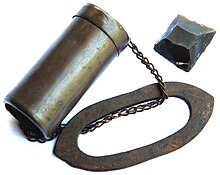Tinderbox: Difference between revisions
Lexington50 (talk | contribs) mNo edit summary |
Lexington50 (talk | contribs) mNo edit summary |
||
| Line 9: | Line 9: | ||
In prehistoric times [[flint]] and [[pyrites]] might be used, and flint and [[steel]] from the [[Iron age]] onward <ref>[http://books.google.com/books?id=5jsOAAAAYAAJ&pg=PA272&dq=%22tinder+box%22+date:1400-1900&lr=&as_brr=0]</ref>. The flint is chipped to provide a sharp edge suitable for striking with the steel. Note that any suitably hard rock, such as [[quartzite]], may be substituted for flint. The firesteel is simply a piece of tempered [[carbon steel]], as it is difficult to obtain sparks using this method with ordinary [[iron]] or [[stainless steel]], often formed in a "D" shape so it can be looped around two or three fingers for striking. <ref>Mors Kochanski, <i>Bush Craft: Outdoor Skills and Wilderness Survival</i> (Edmonton: Lone Pine Publishing, 1987), p. 16</ref> |
In prehistoric times [[flint]] and [[pyrites]] might be used, and flint and [[steel]] from the [[Iron age]] onward <ref>[http://books.google.com/books?id=5jsOAAAAYAAJ&pg=PA272&dq=%22tinder+box%22+date:1400-1900&lr=&as_brr=0]</ref>. The flint is chipped to provide a sharp edge suitable for striking with the steel. Note that any suitably hard rock, such as [[quartzite]], may be substituted for flint. The firesteel is simply a piece of tempered [[carbon steel]], as it is difficult to obtain sparks using this method with ordinary [[iron]] or [[stainless steel]], often formed in a "D" shape so it can be looped around two or three fingers for striking. <ref>Mors Kochanski, <i>Bush Craft: Outdoor Skills and Wilderness Survival</i> (Edmonton: Lone Pine Publishing, 1987), p. 16</ref> |
||
The [[char cloth|charcloth]] |
The [[char cloth|charcloth]] is fabric made from vegetable fiber (e.g. [[cotton]], [[linen]], or [[jute]]) which has previously been chared via [[pyrolysis]], giving it a low ignition temperature and slow burning characteristics suitable for use as tinder.<ref>[http://books.google.com/books?id=f5oDAAAAYAAJ&pg=PA196&dq=%22tinder+box%22+date:1400-1900&lr=&as_brr=0]</ref> The sparks (actually pieces of burning steel broken off by the harder flint) would ignite a very small fire as they fell onto the charcloth, the glow of which could in turn be used to ignite a wood splint, after which the cloth would be extinguished for further use. It took skill and about a half hour to start a fire. In the early 19th century a rotating metal wheel was used to create the sparks with superior results, and the wood splint might have been dipped in [[sulfur]] (sort of a primitive nonstriking match) for better results. The sulfur tipped matches were the results of household manufacture and were sold by "matchgirls".<ref>[http://books.google.com/books?id=fRwPAAAAYAAJ&pg=PA502&dq=%22tinder+box%22+date:1400-1900&lr=&as_brr=0#PPA501,M1]</ref> |
||
Some nonindustrialized societies used a [[bow drill]] to spin a stick and achieve sufficient heat to ignite wood shavings, but this is far harder to achieve than with flint and steel. |
Some nonindustrialized societies used a [[bow drill]] to spin a stick and achieve sufficient heat to ignite wood shavings, but this is far harder to achieve than with flint and steel. |
||
Revision as of 07:54, 27 July 2008

Historically, a tinderbox is a small container containing flint, firesteel, and tinder (typically charcloth, but possibly a small quantity of dry, finely-divided fibrous matter such as straw), used together to help kindle a fire. Tinderboxes fell out of general usage when matches were invented.
In prehistoric times flint and pyrites might be used, and flint and steel from the Iron age onward [1]. The flint is chipped to provide a sharp edge suitable for striking with the steel. Note that any suitably hard rock, such as quartzite, may be substituted for flint. The firesteel is simply a piece of tempered carbon steel, as it is difficult to obtain sparks using this method with ordinary iron or stainless steel, often formed in a "D" shape so it can be looped around two or three fingers for striking. [2]
The charcloth is fabric made from vegetable fiber (e.g. cotton, linen, or jute) which has previously been chared via pyrolysis, giving it a low ignition temperature and slow burning characteristics suitable for use as tinder.[3] The sparks (actually pieces of burning steel broken off by the harder flint) would ignite a very small fire as they fell onto the charcloth, the glow of which could in turn be used to ignite a wood splint, after which the cloth would be extinguished for further use. It took skill and about a half hour to start a fire. In the early 19th century a rotating metal wheel was used to create the sparks with superior results, and the wood splint might have been dipped in sulfur (sort of a primitive nonstriking match) for better results. The sulfur tipped matches were the results of household manufacture and were sold by "matchgirls".[4]
Some nonindustrialized societies used a bow drill to spin a stick and achieve sufficient heat to ignite wood shavings, but this is far harder to achieve than with flint and steel.
In the 18th century, tinderboxes were in common use.[5].
A book from 1881[6] notes that back in 1834 an editor had predicted[7] that despite the advent of "lucifers" (matches), the tinder box would likely continue to be common in the household, but that in fact, by 1884, it was only seen in museums. A book from 1889 describes such a tinderbox[8] and says that the wear patterns on the flint are like those on ancient prehistoric flints in the collection.[9]
In conventional usage, the term "tinderbox" refers to something that is so dry that it could catch on fire with the slightest provocation, perhaps even spontaneously.
